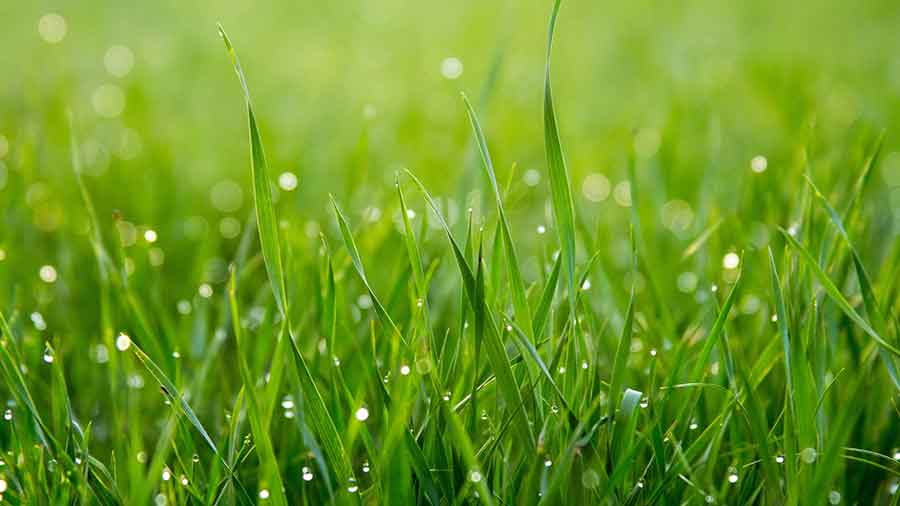Some of us may have some leftover grass clippings from mowing the lawn and maybe wondered if it could be used to fertilize our plants. Grass after all is organic and when we have a container garden at home, it is advisable to use organic fertilizers. Instead of throwing away those grass clippings, it may be a good idea to work the grass into the soil.
I’m sure if you have been gardening for a long time, you have oftentimes wondered if a particular organic material can be used as fertilizer. Do grass clippings make good fertilizer? There are 3 primary nutrients needed by plants, namely, nitrogen, potassium, and phosphorus. And since grass is very rich in nitrogen, it makes sense to use grass clippings as fertilizer. Grass clippings are particularly effective in the vegetative stage of a plant. An effective and efficient method of using grass as fertilizer is to make a grass clipping tea fertilizer.
Grass Clippings is Rich in Nitrogen
One important nutrient that a plant must have is nitrogen. Nitrogen is needed in the plant’s vegetative stage. This is the stage where plants vigorously grow leaves and shoots. It is the stage after germination and just before the plant begins to flower.
Nitrogen is needed by plants to produce chlorophyll, which makes the leaves green. Chlorophyll, which is a green pigment, is present in all green plants and is responsible for the absorption of light to provide energy for photosynthesis. Without photosynthesis, they can’t make their own food so they eventually die. A sure sign of nitrogen deficiency is when the leaves start turning yellow.
The other important nutrients needed by plants are phosphorus and potassium. Phosphorus is needed for root development while potassium is needed in the flowering or fruiting stage of the plant.
Making a Tea to Extract Nitrogen From Grass
Some people use grass clippings as a mulch. Mulching provides many benefits to a garden. It is used to retain soil moisture, prevent weeds from growing by blocking sunlight, and in an organic mulch, it provides nutrients to the plants.
Grass clippings as an organic mulch is an excellent way to retain soil moisture. But for it to become fertilizer, then it is best to make a grass clipping tea. This is because grass needs to be decomposed first before the nitrogen can be used.
It may take a month for the grass to be decomposed by beneficial microbes and earthworms. Additionally, you should not disturb the soil by tilling or digging as it will kill the good microbes. If it is made into a tea, then nitrogen can be extracted in 3-5 days only. When making a grass clipping tea, you simply add water to the clippings and let the nutrients steep into the water.
The final product becomes a nitrogen-rich liquid fertilizer for your plants.
How to Make a Grass Clipping Tea Fertilizer
One of my favorite ways to supply nitrogen to my plants is the grass clipping tea fertilizer. This organic fertilizer has been used by many gardeners and farmers for centuries. Aside from being free, it is also very easy to make.
The idea here is simple. You simply have to soak the grass clippings in water so that the nutrients will seep into the water, just like making tea.
Let me share with you how I make this fertilizer.
Here are the materials you need
- Bucket
- Cloth or newspaper
- Yarn, or rubber band (or any piece of string)
- Ladle
- Grass clippings
- Water
- Collect the clippings to fill half a bucket. You have to make sure that it is free from synthetic herbicides or other chemicals. The chemicals will kill the good microorganisms that will extract the nutrients. If there are chemicals present in the grass, then it is best to use it as compost. Simply throw it in your composting bin.
- Place the grass clippings in a bucket or a deep container. If the clippings are a bit bigger, simply cut them into small pieces using a pair of scissors. This will speed up the extraction process. By cutting it into small pieces, you are increasing the surface area where the “juices” from the grass will steep into the water. In tea preparations, this process is sometimes called infusion.
- Add water to fill the bucket to the top. When using water from the tap, it is best if you let the water stand overnight before using it. This removes the chlorine from the water. Chlorine kills the good microbes in the grass clippings. It is actually better to use rainwater.
- Cover with paper or cloth or any porous material such as newspaper. This is to avoid insects laying their eggs in the mixture. Secure the cover using yarn or rubber band. Do not use a solid or non-porous material to cover the bucket. Doing this will rapidly foul your mixture because of lack of air circulation. Let it sit for 3-5 days. Make sure to place it in a cool, dry place away from direct sunlight.
- Mix the concoction daily for about 2-3 minutes before covering it again. Just mix it slowly using a ladle.
- To use, simply strain out the solid particles. Use it to water your plants about 2 times a week. You can throw away the solids in your compost bin. Apply every other week.
It is advisable to use it immediately as the mixture tends to foul rapidly. This will also depend on the type of grass that you are using. If it starts to stink, then you have to discard it already.
How to Apply the Grass Clipping Tea Fertilizer
There is no need to dilute the fertilizer in water. However, it all depends on the ratio of your grass clippings to your water. If the liquid is too dark, then you should dilute it first. The ratio is 1:2. For every 1 part of liquid fertilizer, use 2 parts of water.
For example, dilute 500 ml of the liquid fertilizer in 1 liter of water. With this mixture, you can use it to water or drench your plants directly. Another method of applying it is to use it as a foliar fertilizer. Foliar feeding is when the fertilizer is applied directly to the leaves of a plant, usually through spraying.
With foliar feeding, the nutrients are absorbed directly through the leaves of the plant. The leaves absorb the nutrients through the stomata. It is best to spray the fertilizer in the early morning or late afternoon. This is when the plant’s stomata are open.
Alternatives to Grass Clippings
Sometimes you just don’t have grass growing in your backyard. Don’t worry because aside from grass, other sources of nitrogen can be just any weed or plant. Using excess green leafy vegetables can also be used.
They are rich in nitrogen and growth hormones. I like to use spinach for this type of fertilizer because it is very rich in nitrogen and potassium, although you can use any green leafy vegetable.
If you don’t have time to mix up some grass and water, you may use green tea instead.

Green tea is rich in nitrogen and has many micronutrients beneficial to plants such as Manganese and Zinc. Manganese contributes significantly to plants by keeping the leaves greener and preventing diseases in the roots. Zinc also prevents the discoloration of leaves and helps in the development of chlorophyll.
To use, remove the used tea from its bag. Mix in 1 liter of water and let it sit for 1 hour. Pour in the sprayer and spray on all parts of the plant. It can also be placed directly into the soil. It helps protect the roots against bad bacteria. Apply once a week only. Some teas may have caffeine and it can increase the acidity level of the soil.
Reminders on using Nitrogen-Rich Fertilizers
As mentioned above, the grass clipping tea fertilizer is best used in the vegetative stage of plants. When the plants start to flower, then it is best to use fertilizers rich in potassium. Using nitrogen-rich fertilizers during the flowering stage of plants may cause them to grow disproportionately.
Instead of producing more flowers, the plant will grow more leaves and branches. If you are planting peppers or tomatoes, then fruits may become stunted or deformed. Apply potassium-rich fertilizers when they are in the flowering and fruiting stage.
For this reason, the grass clipping tea fertilizer is best used for green, leafy vegetables such as lettuce, kale, rocket, and spinach. It is also recommended for newly transplanted seedlings.










